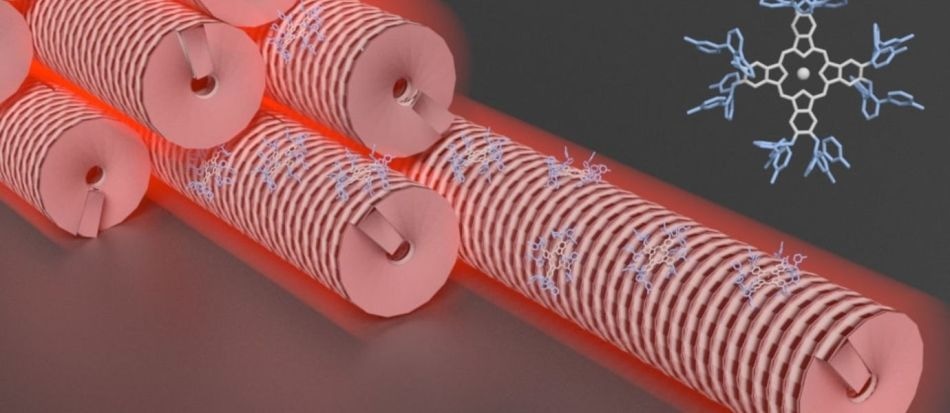Aug 13 2019
A study team from Aalto University has formulated an original strategy to develop virus-based materials for catalysis. The project, which is outlined within the Horizon 2020 Marie Skłodowska-Curie actions, aims to make the way for the application of optically active biohybrid materials—a blend of biomolecules and synthetic moieties—in fields ranging from nanomedicine to environmental sciences or green organic synthesis.
 Schematic representation of the photoactive rod-like virus bundles glued together by action of the dye (top-right corner). (Image credit: Aalto University)
Schematic representation of the photoactive rod-like virus bundles glued together by action of the dye (top-right corner). (Image credit: Aalto University)
Our first challenge was to select the right photosensitizer. We decided to employ phthalocyanines, a synthetic derivative of hematoporphyrin (the dye responsible for the colour of blood), due to their outstanding properties as a reactive oxygen species generator. However, the use of this kind of dyes in aqueous media presents several challenges that affect their performance. Therefore, careful design was necessary to maintain their properties.
Eduardo Anaya, Postdoctoral Researcher, Aalto University
In partnership with Professor Tomas Torres’ study group from the Universidad Autonoma de Madrid, a new phthalocyanine derivative was synthesized, resulting in a molecule with strong properties in various ionic strength media. The design guaranteed the photoactivity of the dye even in an aqueous setting.
One of the focuses of our research group lies in the design of new protein assemblies and their potential application as new materials. Our approach is based on supramolecular interactions, such as electrostatic binding so, in this project, we decided to combine the positively charged dye with a negatively charged tobacco mosaic virus (a 300 nm long rod-like virus), resulting in a photoactive fibrous material.
Mauri Kostiainen, Professor and Leader of Biohybrid Materials Group, Aalto University
Kostiainen continued, “This approach led to highly ordered threads, which were thoroughly characterised by X-ray scattering and several microscopy techniques in the Nanomicroscopy Center at Aalto.”
Besides the structural characterization, Anaya highlights that the most important feature is that the dye stays active regardless of being immobilized in the fibers. “We can fix the reaction site in solid support and pass the solution we want to react through it, being visible light the only “fuel” we use for it to happen. This allows us to create a continuous flow set-up that enable the scaling up of the oxidation process,” he concludes.
The study team engineered a proof-of-concept device where immobilizing the fibers within a glass capillary; an incoming flow was oxidized in numerous cycles. The resilience of the fibers was evaluated, concluding that both their photoactivity and structural stability stay constant over time. One extra advantage is that, once the oxidation process is done, a light pulse can take apart the fibers, making it easy to get rid of.
The reported method signifies the primary step towards the use of biohybrids in continuous flow reactions, which signify an eco-friendly approach to this kind of industrial process.
The results were reported in Advanced Materials on August 8th, 2019.